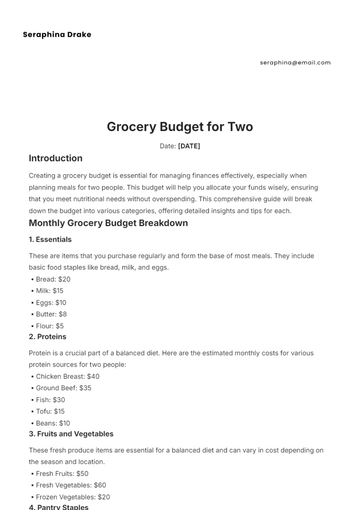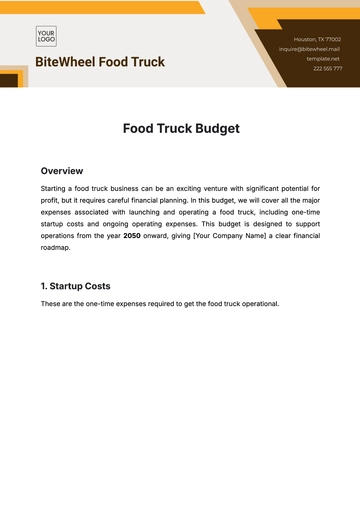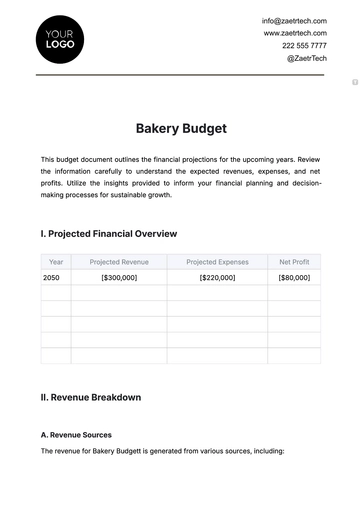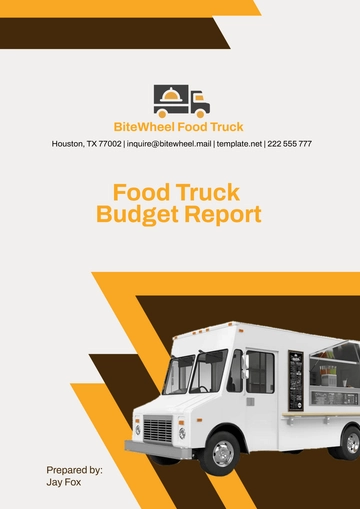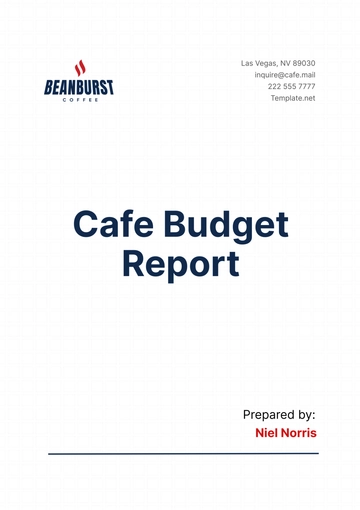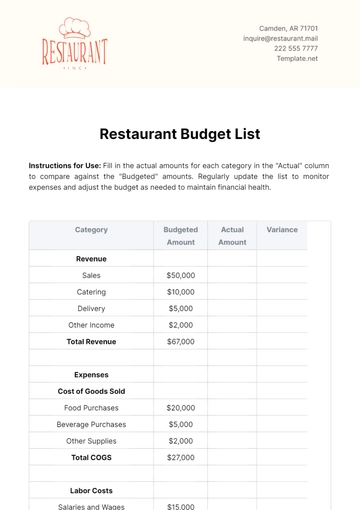Free Food Truck Budget
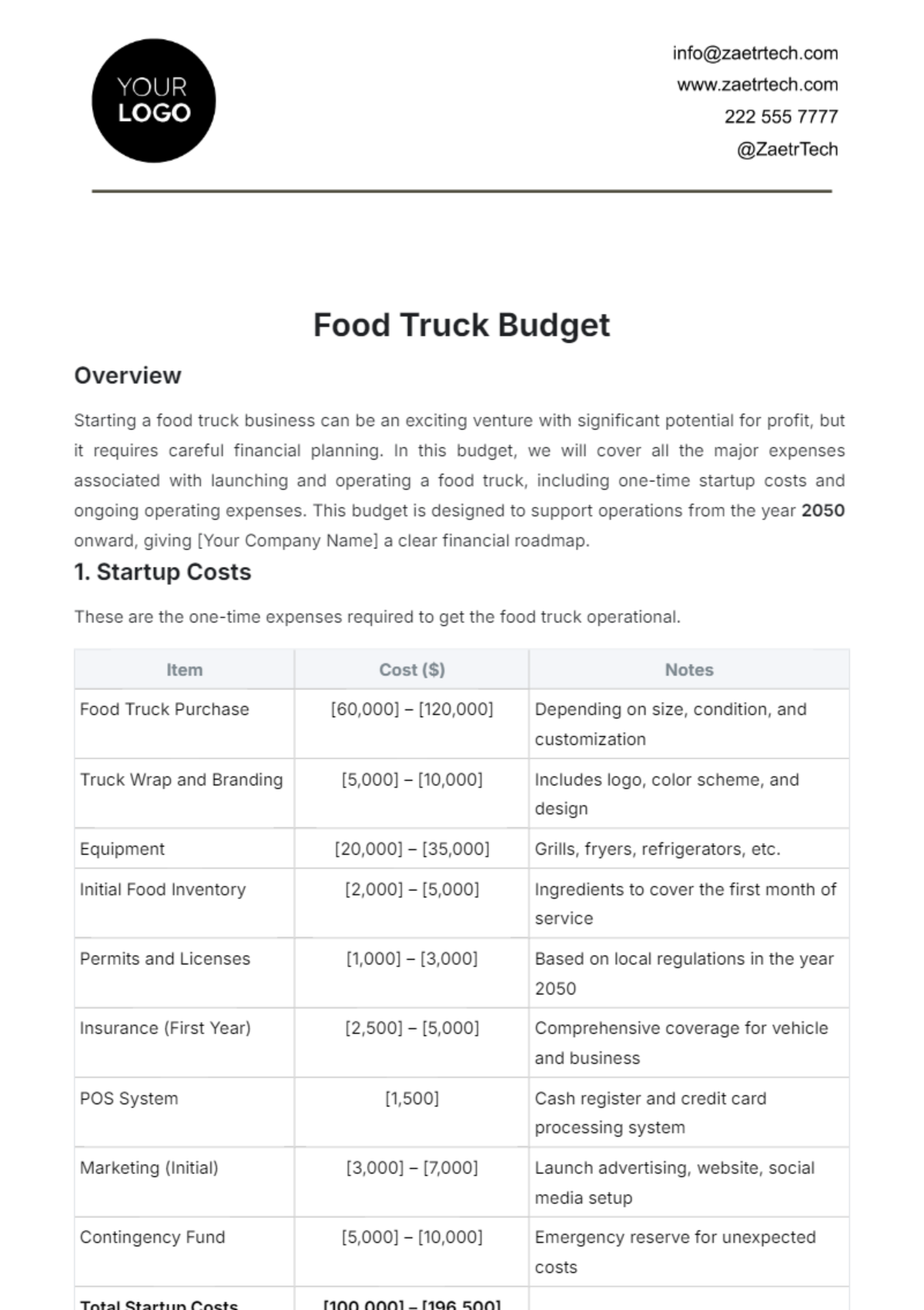
Overview
Starting a food truck business can be an exciting venture with significant potential for profit, but it requires careful financial planning. In this budget, we will cover all the major expenses associated with launching and operating a food truck, including one-time startup costs and ongoing operating expenses. This budget is designed to support operations from the year 2050 onward, giving [Your Company Name] a clear financial roadmap.
1. Startup Costs
These are the one-time expenses required to get the food truck operational.
Item | Cost ($) | Notes |
|---|---|---|
Food Truck Purchase | [60,000] – [120,000] | Depending on size, condition, and customization |
Truck Wrap and Branding | [5,000] – [10,000] | Includes logo, color scheme, and design |
Equipment | [20,000] – [35,000] | Grills, fryers, refrigerators, etc. |
Initial Food Inventory | [2,000] – [5,000] | Ingredients to cover the first month of service |
Permits and Licenses | [1,000] – [3,000] | Based on local regulations in the year 2050 |
Insurance (First Year) | [2,500] – [5,000] | Comprehensive coverage for vehicle and business |
POS System | [1,500] | Cash register and credit card processing system |
Marketing (Initial) | [3,000] – [7,000] | Launch advertising, website, social media setup |
Contingency Fund | [5,000] – [10,000] | Emergency reserve for unexpected costs |
Total Startup Costs | [100,000] – [196,500] |
2. Monthly Operating Costs
The ongoing costs for keeping the food truck business running, which will continue as long as the business operates.
Expense Category | Estimated Monthly Cost ($) | Notes |
|---|---|---|
Fuel | [500] – [1,200] | Based on mileage and fuel efficiency |
Food Supplies | [2,500] – [7,000] | Adjusted for menu items and seasonal changes |
Employee Wages | [5,000] – [12,000] | Based on the number of staff and hours worked |
Truck Maintenance | [300] – [1,000] | Covers repairs, oil changes, and tune-ups |
Marketing & Advertising | [500] – [1,500] | Ongoing promotion through social media and ads |
Insurance | [200] – [500] | Monthly breakdown of yearly cost |
Permit Renewals (Monthly Avg.) | [100] – [250] | Depending on city/state regulations |
Miscellaneous Expenses | [200] – [500] | Small, unexpected expenses (e.g., fees, tools) |
Total Monthly Operating Costs | [9,300] – [23,950] |
3. Yearly Revenue Projections
For planning purposes, it's important to estimate yearly revenue based on projected sales, average ticket size, and customer volume. These estimates assume moderate success in the first year with growth in subsequent years.
Year | Projected Sales ($) | Notes |
|---|---|---|
2050 | [250,000] – [400,000] | First-year sales, assuming a steady customer base |
2051 | [350,000] – [500,000] | Projected increase due to growing brand awareness |
2052 | [450,000] – [600,000] | Potential revenue after establishing a loyal base |
4. Break-Even Analysis
To calculate the break-even point for [Your Company Name]'s food truck business, we look at total startup costs and projected monthly operating expenses. Here's an example of the break-even point based on the first year's projections:
Total Startup Costs: [$150,000] (Average of startup costs)
Total Monthly Operating Costs: [$15,000] (Average of monthly expenses)
Projected Monthly Revenue in 2050: [$30,000]
[Your Company Name] can expect to break even within 10 months of starting operations if revenue and expenses align with the estimates.
5. Long-Term Financial Goals (2050-2060)
Over the first decade of operation, [Your Company Name] should aim for growth through increasing sales, expanding the food truck fleet, or even opening a brick-and-mortar location. The financial strategy should focus on reinvesting profits and managing cash flow efficiently.
Key Milestones:
Expand Menu and Offerings – By 2052, add new food items to attract more customers.
Second Food Truck Purchase – By 2054, plan for purchasing a second truck. Estimated cost: [$80,000] – [$130,000].
Brick-and-Mortar Expansion – By 2060, explore the possibility of opening a physical restaurant. Expected investment: [$500,000] – [$1,000,000].
- 100% Customizable, free editor
- Access 1 Million+ Templates, photo’s & graphics
- Download or share as a template
- Click and replace photos, graphics, text, backgrounds
- Resize, crop, AI write & more
- Access advanced editor
Keep your food truck’s finances on track with the Food Truck Budget Template from Template.net. This editable and customizable template allows you to monitor expenses, sales, and profits. Tailor it using our Ai Editor Tool to ensure financial efficiency for your food truck operations.
You may also like
- Budget Sheet
- Personal Budget
- Non Profit Budget
- Monthly Budget
- Project Budget
- HR Budget
- Company Budget
- Home Budget
- Weekly Budget
- College Budget
- Business Budget
- Construction Budget
- Small Business Budget
- Hotel Budget
- Annual Budget
- Home Renovation Budget
- Household Budget
- Student Budget
- Grocery Budget
- Marketing Budget
- Corporate Budget
- Startup Budget
- Manufacturing Budget
- Church Budget
- University Budget
- Annual Budget Plan
- Event Budget
- Operating Budget
- Travel Budget
- Food Budget
- IT and Software Budget
- School Budget
- Real Estate Budget
- Sales Budget
- Conference Budget
- Budget Finance
- Freelancer Budget
- Budget Advertising
